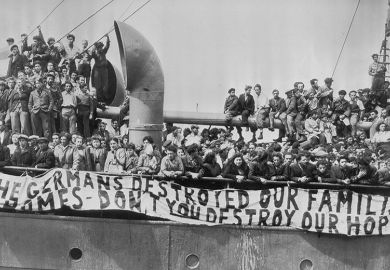In studying the past, historians often have cause to pause and wonder: “What would that have been like?” or “How would I have felt in that situation?” In many ways, life under the Nazis raises that ultimately unanswerable but fascinating question of: “How would I have responded to this set of circumstances? What would I have done, or not done?” So much ink has been spilled writing about Hitler’s Germany that one would be forgiven for wondering if there really can be anything new to say. But the answer to that question is: yes.
Over the past decade, historians of Nazi Germany have found examining the perspectives of the perpetrators (Täterforschung) to be a particularly productive line of enquiry. Christian Ingrao’s The Promise of the East adds to this rich vein of research, putting the German quest for Lebensraum (living space) in the spotlight, and examining, among other things, the emotional worlds of those who sought to deliver on the Germanisation of Europe.
Building on Götz Aly’s important work about the Nazi East, Ingrao’s research deepens our understanding of why the idea of building a racially pure imperial Utopia in eastern Europe gained such traction among Germans of all social and cultural backgrounds. He points out that nearly 30,000 Germans, many of them volunteers, went to eastern Europe in the hope of helping to Germanise the area. And he seeks to shed light on why such strong emotions were aroused by the Nazi dream in the East. Ingrao invites us to consider Nazism as a promise to deliver a different kind of society. His work reveals a real fervour for a realised Nazi Utopia among the Germans who went there committed to making it happen.
This fervour was driven in part by negative narratives suggesting that ethnic Germans in eastern Europe were under threat, cut off from the Reich, but also by a much more positive aspiration for a glorious future as an ethnically homogeneous German bloc. Former Nazi youth leader Melita Maschmann later wrote about her time in the Nazi East, explaining: “I experienced Volksgemeinschaft [German people’s community] with such intense feelings of happiness that it generated in me an optimism which held me in its thrall up until 1945.” The “intensity of the Nazi investment in its imperial hope”, Ingrao suggests, meant that Germans like Maschmann did not want to abandon their dream, even at the cost of what they saw as more than 25 million “non-native” people who were resettled or liquidated as a means of ensuring racial purity.
Careful and considered, Ingrao effectively explains his approach and the reasoning behind his conclusions. The thorough way in which this research is presented does mean that it is not the most accessible of books and will therefore be of greater interest to specialists than to a general readership. There is no doubt, however, that for historians of Nazi Germany The Promise of the East makes new and insightful contributions to a crowded field.
Hester Vaizey is a fellow of Clare College, Cambridge and the author of Surviving Hitler’s War: Family Life in Germany, 1939-48 (2010).
The Promise of the East: Nazi Hopes and Genocide, 1939-43
By Christian Ingrao; translated by Andrew Brown
Polity, 320pp, £25.00
ISBN 9781509527755
Published 23 November 2018
Register to continue
Why register?
- Registration is free and only takes a moment
- Once registered, you can read 3 articles a month
- Sign up for our newsletter
Subscribe
Or subscribe for unlimited access to:
- Unlimited access to news, views, insights & reviews
- Digital editions
- Digital access to THE’s university and college rankings analysis
Already registered or a current subscriber?







